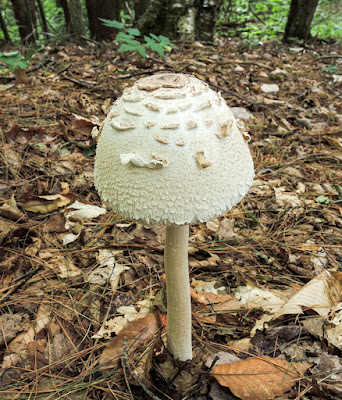I've recently been having very interesting conversations about the meaning that is embedded in an artwork: are we to see abstract work as a composition consisting of shape, color, space, light, or is there content in addition to the formal concerns of the work? John Chamberlain is an interesting artist to think of in this context. I wrote about the marvelous retrospective at the Guggenheim Museum in 2012, where I saw the sculpture as purely about color and shape, and surprising moments of juxtaposition and detail. Seeing a stunning show of Chamberlain's sculpture currently at Gagosian Gallery has prodded me to think about what it means that he used industrial scrap metal and parts of cars in his sculpture.
In the work above––I'm sorry not to have titles and dates, but some galleries have taken to not having check lists, or even reproducing the work on their websites, which is very frustrating––a curved red clamshell shape sits atop crumpled blue forms, almost like an open mouth. Are we to think of a figure?
This very large sculpture of compressed and varied forms, one side primarily blues, another yellows, made me think of a landscape in its multitudinous parts and its complexity. It also feels like a raucous free jazz composition, form piled upon form, sometimes discordant, in other parts fluid.
I couldn't help but see a crowd of moving figures, as though on a busy sidewalk. This is such a dynamic piece, and it reminded me of Philip Guston's painting Monument, a scrum of legs and feet.
This is a stunningly dramatic piece, with smooth thin forms reaching high, fluid rounded shapes nestled one against the other. But all these observations of mine are about image, what the whole of the sculpture brings to mind.
As here, with another monumental piece that looks to me like an animated creature, rustling as it moves. Chamberlain's magical expertise with folding, crushing, and welding sometimes lets us forget that this is metal that he's working with, and not malleable clay or cloth.
Yet there is metal's rigidity and sharp edges, its shiny surfaces, its shapes that are sometimes clearly part of an automobile's body.
In this detail of the other side of the sculpture pictured above, Chamberlain has included parts of a car that are clearly elements of a bumper, smoothly protruding; they could be from a
1951 Ford coupe. Does this clear reference to the origin of Chamberlain's materials indicate that some of the meaning of his work lies in industrial automobile manufacture? is there a critique of American addiction to cars and the open road? or a paean to American know-how and design, as with the
American Precisionists of the early 20th century?
I would answer "no", for the most part. Of course I have to acknowledge the source of Chamberlain's materials, but for me that does not determine the meaning of the work, which I find in responding to its form. I don't know if he was attracted to scrap metal because of its origins, or because of the way it behaved and looked when made into a sculpture. Chamberlain himself, in speaking of the meaning of his work said:
"Even if I knew, I could only know what I thought it meant."
We artists cannot determine what meaning observers find in our work. What we prefer people to see is not always what they will see. For me, looking at a non-objective work is a rich experience, noting the way form and color interact, the quietude or dynamism of a composition. I find meaning in these things, and a deep emotional satisfaction. In recent years I've had two extraordinary experiences standing in front of a painting, paintings which caused me to weep at their beauty and depth of feeling. One was at the National Gallery in London:
 |
| Piero di Cosimo, Satyr Mourning a Nymph, ca. 1495 |
I wrote about this remarkably tender painting
here. Not only is the narrative touching, but the form and structure of the work are in perfect harmony with its story.
The other was a Mondrian in the collection of the Hartford Atheneum:
 |
| Piet Mondrian, Composition in Blue and White, 1935 |
The simplicity and perfection of this painting struck me so strongly. In a photo image it appears much more flatly painted than it does in person. My point in showing these two paintings, so different in subject and separated by centuries, is that response to a work does not have to be tied to its subject; meaning can reside in narrative, and it also can be found in pure form. To be honest, I was surprised at my unbidden spell of weeping in front of the Mondrian, but it proves to me that a reductive work of art can be as important to me as one of representation and narrative; form in itself carries meaning.






























































